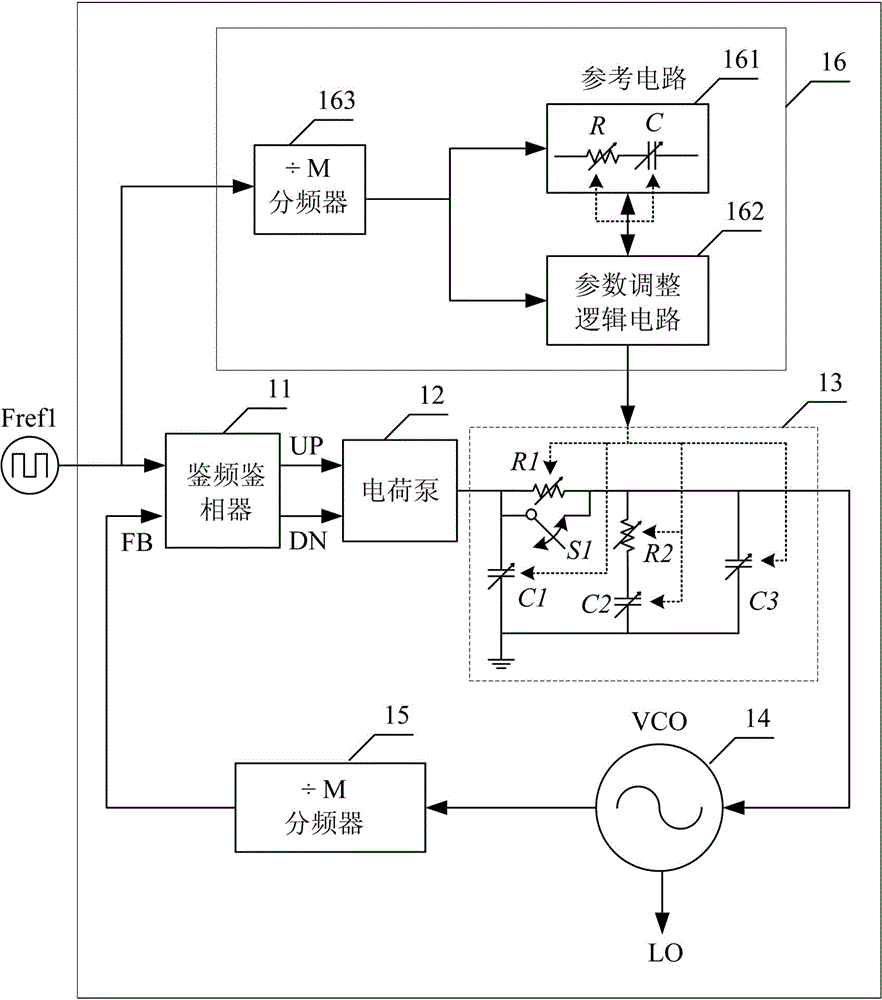Self-calibration device and method for loop parameters of phase-locked loop
A technology of loop parameters and self-calibration, applied in automatic power control, electrical components, etc., can solve the problems of increasing chip area and cost, large chip area, and poor temperature compensation effect, so as to achieve good temperature compensation effect and overcome The effect of large chip area and small chip area
- Summary
- Abstract
- Description
- Claims
- Application Information
AI Technical Summary
Problems solved by technology
Method used
Image
Examples
Embodiment 1
[0065] According to the sequence in the loop, the phase difference (frequency difference) between the reference clock signal and the frequency-divided output signal output by the VCO14 output through the variable frequency divider 15 is compared with the phase difference (frequency difference) between the two through the frequency detector and phase detector 11, and the pair loop of the charge pump 12 is determined. Whether the circuit filter 13 is charging or discharging, of course, this is also determined by the voltage-frequency characteristic curve of VCO14 (usually select the positive voltage-frequency characteristic curve, and the negative voltage-frequency characteristic curve is the opposite): if the frequency of the reference clock is higher than the frequency-divided output signal frequency, or the phase of the reference clock signal is ahead of the phase of the frequency division output signal, then the frequency detector 11 and the charge pump 12 work together to mak...
Embodiment 2
[0070] As shown in Figure 5(b), the RC reference circuit 161 includes an RC core module 1611'', a module 1612'' that provides a current source or voltage bias to the RC core module, and a module that supplies power to these two modules 1613'' (probably an LDO, or a DC-DC module). The core module RC core module 1611'' in this RC reference circuit 161. The RC core module 1611'' is a part of an RC oscillator. A typical implementation example of this RC oscillator is shown in Figure 5(b). By setting NMOS transistors with different width-to-length ratios, the Vgs of the two transistors The difference generates a reference current on the resistor R, which charges C through the mirror circuit, and the frequency of the output signal is closely related to the values of R and C, and this oscillator may be a module in the entire transceiver, or It may be a separate module, which can be integrated in the IC of the entire transceiver.
[0071] The loop parameter calibration process is ...
Embodiment 3
[0074] As shown in FIG. 5(c), the RC reference circuit 161 includes an RC core module 1611''', a module 1612''' that provides a current source or voltage bias for the RC core module, and a module 1612''' for the two Module power supply module 1613''' (may be an LDO, or DC-DC module). The RC core module 1611''' is a part of an RC oscillator. The typical implementation example of this RC oscillator is shown in Figure 5(c). By setting NPN transistors of different areas, the difference of Vbe of the two transistors is A reference current is generated on the resistor R, and this current is charged to C by mirroring the mirror circuit, and the frequency of the output signal is closely related to the values of R and C, and this oscillator may be a module in the entire transceiver, or it may It is a separate module that can be integrated in the IC of the entire transceiver. The loop parameter correction process is the same as that in Embodiment 2.
[0075] method embodiment ...
PUM
 Login to View More
Login to View More Abstract
Description
Claims
Application Information
 Login to View More
Login to View More - R&D
- Intellectual Property
- Life Sciences
- Materials
- Tech Scout
- Unparalleled Data Quality
- Higher Quality Content
- 60% Fewer Hallucinations
Browse by: Latest US Patents, China's latest patents, Technical Efficacy Thesaurus, Application Domain, Technology Topic, Popular Technical Reports.
© 2025 PatSnap. All rights reserved.Legal|Privacy policy|Modern Slavery Act Transparency Statement|Sitemap|About US| Contact US: help@patsnap.com



